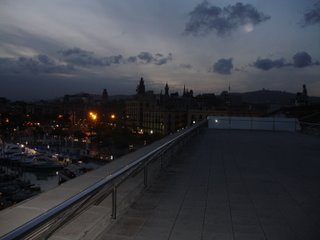
My new friend, Miguel.
So we took a walk around city center and Miguel told me about the history of the city, which was really fascinating. I may be wrong on a few things, but he said he'd edit my entry later for mistakes.

The Catedral. It's currently under renovation.

Lady singing opera outside the Catedral in the Gothic quarters. She was there the next day as well.

The city of Barcelona is built on the ruins of the Roman city of Barcino. This part has been escavated and lies exposed. They discover bits and parts of the ruins as time goes on. It makes it difficult, however, because whenever they try to build new things, they find ruins and the escavating and preserving processes slow down construction. i.e. With the Metro, they had to build around these areas.
It really makes you think. After being in Europe, you realize how little history we have to preserve in Los Angeles. And what little history we do have, we don't really make huge efforts to preserve. While this may seem like a bad thing, the positive side is that we are able to build without much concern as to what we are destroying, thus improving the economy. On the otherhand, we don't have the cultural richness of a city like Barcelona, or even that of London (much of it only dating back to early 1600's after the Great Fire). It's an interesting balancing act.


Strangest thing! When we walked into the city square where the City Hall faces the building that houses the head of the Catalonian government (like a State Capitol), there was a big X on the sky right above us! Miguel said it was a sign from the heavens marking this place as the center of world, which it used to be prior to the discovery of America.

Remaining four columns from the Barcino forum.

These are the very steps where King Ferdinand and Queen Isabella received Christopher Columbus after he "discovered" America. With him, Columbus had brought from native peoples to these steps. That's me sitting on the steps in the picture. Just another American brought to see the Old World!
Miguel explained a lot about the history of Spain. Spain was actually not a united kingdom until Ferdinand of Aragon and Isabella of Castile married and went around conquering neighboring nations and creating a united kingdom. To this day, Spanish people identify themselves as Castilian, Catalonian, Basque, etc. Barcelona is part of Catalonia which was part of the Kingdom of Aragon. Prior to the discovery of America, Barcelona had been the central port of the Mediterreanean. After, however, the world became bigger and trade was going from America to Spain, and Seville (in Castile) became the primary port. Barcelona, more or less, became abandoned, an afterthought of Spain.

Inside the Santa Maria del Mar Cathedral.



These are views from the Museu d'Historia de Catalunya (Museum of Catalonian History).

Me in Barcelona!
Oh...side note, but after the formation of the EU, it kind of sucks but they don't necessarily give you stamps in your passport when you enter and exit European countries from another European country. I'm still trying to figure out how it really works now, but look, I got a stamp!

I'll get to the rest of my Barcelona excursion in my next entry. Muchos gracias Miguel for showing me around Barcelona!
No comments:
Post a Comment